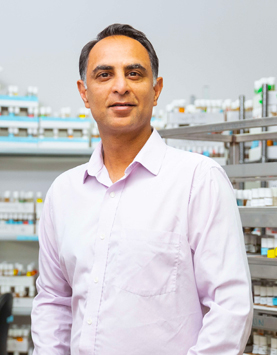Being aware of harmful chemicals in our food is the first step toward curbing them.
The expression “you are what you eat” has now turned ominous. The food itself is not necessarily the problem, it’s the thousands of harmful chemical intruders into our meals. Not only are there more chemicals appearing in the foods we consume, but those chemicals can cause problems with our own digestive and metabolic systems and contribute to obesity.
To be thoroughly terrified, read this article: Are everyday chemicals contributing to global obesity?, which does a deep dive into the topic of “obesogens,” which are chemicals that make organisms inappropriately increase their fat.
 To put things in perspective, Buck professor Pankaj Kapahi, PhD, weighs in on the topic of the chemicals hijacking our bodies and making us fatter.
To put things in perspective, Buck professor Pankaj Kapahi, PhD, weighs in on the topic of the chemicals hijacking our bodies and making us fatter.
The chemicals mentioned in the Chemistry World article that are suspected to be obesogens include:
- plasticisers (compounds to make plastics more durable), including phthalates
- bisphenol A (BPA) and dozens of structurally similar analogs
- flame retardants, including per- and poly-fluoroalkyl substances (PFAS)
- pesticides and herbicides
- surfactants used in waterproof clothing, nonstick cookware, stain repellent, and microwaveable food items, such as perfluorooctanoic acid (PFOA)
- parabens used as preservatives in foods and in personal care products
- the flavor enhancer monosodium glutamate (MSG)
- food emulsifiers, such as dioctyl sodium sulfosuccinate
- food additives, such as carboxymethylcellulose
- artificial sweeteners, such as aspartame, saccharin and sucralose
- and even plain old sugar
To add to the bad news, foods that are safe to begin with can transform with cooking. Kapahi’s lab focuses on a large class of molecules that emerge during frying or grilling. “When you fry foods, the oil is no longer just oil,” he says. “Around 5,000 new chemicals are created,” some of which can increase fat and reduce the calorie expenditure in laboratory mice.
Obesogens are thought to disrupt metabolic signaling, he says. The disruption has a number of effects, including increasing fat storage, reducing a body’s caloric need, altering the microorganisms in the gut, and modifying appetite. All of this just adds to the traditional causes of obesity: too many calories and not enough activity.
“There are chemicals around us all the time,” says Kapahi, whose lab studies, among other things, the additional compounds that are created when foods are cooked. “What is not known are the effects that this multitude of molecules has on our own functioning.”
First the bad news: the list is extensive. The chemicals mentioned in the article that are suspected to be obesogens are found in house dust, water supplies, household items, personal care items, and foods and drinks. They include plasticizers, preservatives, flame retardants, surfactants, and food additives. All of the chemicals have been found in foods people consume, and can be detected in human tissues.
The evidence is clearly accumulating that obesogenic chemicals, wherever they come from, contribute to the obesity epidemic, but measuring how these chemicals affect humans and to what extent is difficult, Kapahi says.
“I think as our society is moving toward more and more synthetic chemicals taking over, there is a lot to be learned about these things,” he says. “We need better tracking of how we are interacting with these different chemicals in our environment and how they are entering our diet.”
Given that this is not likely to occur any time soon, what can people do? Rather than panicking, becoming depressed and giving up eating entirely, Kapahi has some ideas.
“A key thing to remember with obesogen research is that when we do experiments in the lab, we usually? use high concentrations, but what we may be exposed to in our foods may be one tenth or one hundredth or less,” he says. “A critical thing people can do is ensure that they are not exposed to the same chemicals at higher doses,” he says. OK, so how do we do that?
The good news is that there are a few things that can reduce risk. Variety in the diet is a big one. “One of the things I feel can help with the problem is that we shouldn’t just eat the same things every day,” he says. “The more you vary the sources of your food, the less the potential risk of being exposed to any particular chemical.” Bonus: diversity of the diet helps keep gut microbes happy.
The other habits Kapahi personally incorporates from the research include:
- Whenever possible, go for whole foods; processed foods include extra chemicals
- Prepare your own foods; restaurants use a number of methods to get all those great flavors, including grilling and deep frying, plus they add things, such as extra sugar or MSG
- Eat more plant-based, and less cooked foods; make salads a bigger part of meals
- Use boiling and steaming as much safer ways to cook than grilling or frying
- Don’t microwave in any type of plastic container; additional molecules are created when plastic is heated… but microwaving in glass containers is actually safer than normal cooking because it is just heating up water molecules.
“At the end of the day, we can all do our part to minimize our exposure to harmful chemicals,” he says. “I take positivity out of that.”

